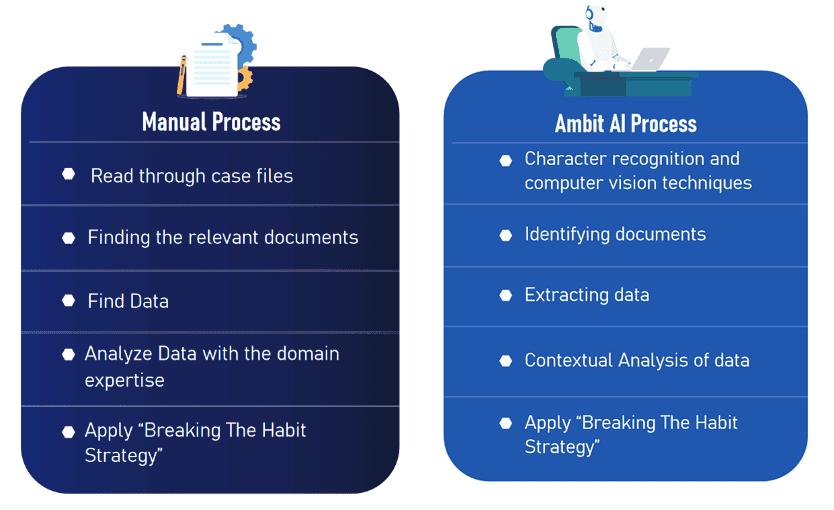Tag: digital transformation tips
To reiterate John F. Kennedy, “Change is the law of life, and those who look only to the past or present are certain to miss the future.”
The digital world revolves around evolution and change. It is constantly transforming from one stage to the next. Do you feel lost in this metamorphosis of digital transformation? Does the fervent adoption of advanced technology into business processes catch you off-guard and unprepared?
We understand and want to help you navigate and thrive in this new era. Stay with us and continue reading.
What Is Digital Transformation?
Digital transformation is the process of utilizing digital technology to develop or modify current corporate practices, culture, and consumer experiences to meet shifting business and market requirements. The perks include better company agility, improved efficiency, and, eventually, the creation of new value for shareholders, consumers, and employees.
According to Gartner, 87% of senior business leaders believe that digitalization should be a top priority for businesses, and 91% of organizations across the globe are currently involved in some sort of digital operation. To improve its client experience, a business might implement AI or cloud computing, for instance. Or it might change its supply chain to ensure machine learning is used more effectively. There are innumerable ways to digitalize your business and reap its many benefits.
Why Is Digital Transformation Important?
The pandemic changed the relevance of digital transformation almost overnight. From a way of enhancing customer care, it quickly became embedded into the core operational and innovative aspects of an organization. In this day and age, an organization’s sustainability may be in jeopardy if it fails to implement digital transformation. This is vital to satisfy the demands of the business landscape. As per Statista, digital transformation has been the leading priority for information technology (IT) initiatives for global companies since 2020.
Businesses are using digital solutions to help them customize their interactions, communications, and goods to meet the unique needs of their clients. For instance, a report by Gartner estimates that by the end of 2020, chatbots will power 85% of customer support. Here are some important reasons why businesses are adopting digital tech:
- Improvement Of Customer Experience – Customer experience is at the core of digital. In order to enhance the customer experience, 92% of business leaders are developing sophisticated digital transformation strategies.
- Additional Data-Based Insights – The tracking and analysis of metrics are made possible by going digital. Making efficient decisions and increasing ROI can both be accomplished by using data-driven insights to better understand customers and re-evaluate business strategies.
- Competitive Edge – By developing new goods and services, entering new markets, and enhancing customer comprehension and service, digital transformation enables organizations to achieve a competitive edge.
- Cost-Cutting – By automating procedures, reducing waste, and improving supply chain management, digital transformation lowers business expenses. A McKinsey study found that businesses that completely adopt Digital Transformation can cut costs by up to 50%.
Stages Of Digital Transformation
Digitization, digitalization, and digital transformation are the three major stages of the Digital Transformation process. A successful implementation requires businesses to move from one stage to the next seamlessly.
- Digitization – The transformation of manual (analog) information into digital format, enabling easy manipulation, storage, and transmission, is called digitization. It is the process of moving to a digital business. For instance, converting paper forms into electronic documents.
- Digitalization – Using digital technologies and digitalized data to enable or improve business processes is known as digitalization. For instance, using a marketing website, software, or mobile app to stay in touch with customers and employees is an example of how digitalization may modify an organization’s operating structure and provide new revenue and value-producing opportunities.
- Digital Transformation – The use of new and developing technologies to encourage sustainable innovation and creative expansion while making fundamental changes in an array of business-related areas. It enhances all aspects of the organization, including how employees engage with clients and how operations are carried out. For example, it collects insights from previous customer data, behavioral patterns, and purchase history to customize products and services offered. That is one of its many benefits.
How To Discover Where Your Business Stands
Legacy challenges are frequently overcome as part of digital transformation, but how effective is it? Measuring the progress of any effort with well-defined KPIs and metrics is the only way to know how far you have come.
Tips to measure the progress of digital transformation:
- Feedback from your employees and co-workers
- Track fluctuations in customer feedback
- Analyze the data across the different initiatives that you have implemented
Some additional metrics to track include:
- The degree of digital adoption
- Customer satisfaction rankings
Receiving feedback and measuring progress this way can help you locate where your business stands in its Digital Transformation process and improve your strategies to drive better results.
The Future Of Businesses In Digital Transformation
From using cutting-edge technologies to making strategic decisions, Digital Transformation is influencing businesses. It alters how firms operate, streamlining operations, boosting efficiency, and establishing a cultural shift. A prediction by International Data Corporation states that 75% of corporate executives will use digital platforms and ecosystem capabilities by 2025 to increase their platforms’ agility, efficiency, and sustainability.
Here are some future trends in Digital Transformation:
1. Low-Code, No-Code
Low-code, no-code is a method of software development that calls for either very little (low-code) or no (no-code) coding at all. As per studies, low-code and no-code platforms will be used for more than 65% of software development by 2024. The market will be valued at $13.8 billion in that year!
2. Cloud Migration
Cloud migration is the act of moving data and applications from one location, typically a company’s on-premises servers, to a public cloud provider’s servers. The four benefits of cloud migration are efficiency, accessibility, scalability, and security.
3. Artificial Intelligence And Machine Learning
AI uses machine learning for data analysis and forecasting to guide efficient digital organizational strategies, personalize interactions, optimize workflows, and offer consistently dependable services 24/7.
Strategizing An Effective Digital Transformation Journey
While undertaking such a big change, it is important to have a foolproof strategy to rely on. Following are a few aspects that you can consider during your digital transformation process:
- Transformation Of Business Strategies – Technology becomes pivotal to business strategy in the aftermath of digital transformation. Operating expenses and inefficiency can be decreased with this strategy.
- Realigning Business Operations – For agility and experimentation, it is essential to transform corporate procedures and adopt new working methods.
- Adopting Novel Methods Of Agility And Experimentation – Modern engineering capabilities must be combined with new working methods as customer expectations and the rate of change increase. Successful digital transformation requires a fundamentally different strategy—one that values the accessibility of technology and the adaptability of people.
- Flexible Technology Is At The Heart Of Long-Lasting Change – Staying fluid and adaptable will enable you to more readily create ecosystem connections that foster speed and scale while also accelerating innovation within your organization.
Watch more: 7 Deadly Mistakes Non-Tech Businesses Make On Tech Projects!
How Can Fingent Help?
Fingent is one of the leading solution providers in the world. We have been around since 2004 and have successfully transformed many businesses from traditional modules into digitalized success stories.
Fingent has expertise in all the technologies that drive a successful digital transformation journey. Specialists in Cloud computing, Artificial Intelligence and Machine Learning, Virtual and Augmented Reality, and more come together to create a holistic digital solution for your business.
Talk with our Digital Consultants, who will analyze your unique requirements and work out a future for your business that is equipped to succeed in the digital age.
Stay up to date on what's new

Featured Blogs
Stay up to date on
what's new



Talk To Our Experts
How the insurance industry delivers service has evolved significantly in the last decade.
Regardless of what form of insurance sales or policy management your organization is engaged in, you can attest that face-to-face interactions are no longer routine and are, in fact, an oddity.
As the insurance industry’s new normal, more and more interactions between customers, industry experts, other organizations, and adjustments claims occur digitally. Though phone-based communications will continue to be a part of the customer service process for the foreseeable future, customers, care providers, other insurers, and virtually anyone else with whom an insurance company interacts have come to expect a largely digitized experience.
For any organization to thrive in the insurance industry of tomorrow, it must take steps to evolve its processes today. That means creating a cohesive modernization strategy and investing in leading-edge technology solutions.
Read more: Answering the Burning Questions of Business Leaders on Digital Transformation!
Top Challenges Facing the Insurance Industry
To understand what a modernized strategy looks like in the insurance industry, it’s vital to examine some of the top challenges businesses will face in the coming years.
1. Staffing Shortages
Historically, the insurance sector has contended with turnover rates somewhere in the range of 8-9%, according to Insurance Business America, but that span climbed to 12-15% by September 2022.
That additional turnover significantly impacts business continuity and diminishes the customer experience. It can also negatively influence insurers’ ability to replace members of leadership that are retiring or stepping away from the industry.
2. Skyrocketing Costs
Inflation and numerous other factors have contributed to rising costs of everything from healthcare to vehicles higher than ever before. Naturally, some of these cost increases are passed onto insurers and their customers, so insurance companies must find ways to absorb some of these expenses while mitigating rate increases for their clients.
Insurers should also explore ways to reduce their operating costs to keep coverage prices lower. Otherwise, businesses may find it challenging to retain customer accounts, particularly in sectors like automotive insurance, where consumers can freely shop around and change policies in six-month intervals.
3. Antiquated Legacy Systems
Some legacy systems hinder the ability of many businesses to embrace digital transformation. These aging platforms can make it challenging to comply with relevant regulatory requirements and increase an organization’s overall operating costs.
The longer that insurance companies cling to antiquated systems, the harder it will be for them to streamline traditionally tedious practices, such as claim management. Therefore, insurance companies must replace these inefficient, disjointed platforms with modern, unified alternatives.
The Role of Digital Transformation in Solving These Challenges
Digital transformation can bring modern technologies to any business process to improve its operation. Fast-growing digital transformation technologies include machine learning, artificial intelligence (like ChatGPT), customer relationship management platforms, and intelligent document processing software.
Digital transformation holds the key to solving the insurance industry’s most significant problems, and it appears that many in the industry realize this, as recent projections estimate that insurance technology spending will increase by 25% between 2022 and 2026 in the US and UK.
A cohesive digital transformation strategy will lay out a roadmap for replacing aging technologies with modern alternatives, and once these technologies have been replaced, the cost savings are almost immediate.
In one example of how a digital transformation strategy led to practical innovation, Fingent joined forces with the California law firm of Sapra & Navarra, LLP to develop Ambit, an AI and ML program that simplifies and enhances the management of workers’ compensation claims. Claims may include hundreds of pages consisting of a variety of letters, affidavits, forms, and other documents from claimants, doctors, lawyers, investigators, employers, and witnesses, among others. Utilizing both artificial intelligence and machine learning, the Ambit system streamlines the claims management process, reducing claim costs, and helps break the old practices of:
- Taking too long to assess claims
- Treating similar claims inconsistently
- Not equipping claim adjusters with modern tools
Instead, Ambit improves the efficiency of all parties — insurance carriers, self-insured companies, lawyers, and claim adjusters — while reducing costs for insurers by 57%.
The Ambit solution was designed to:
- Easily ingest the many documents in the claims process
- Quickly identify missing, processed & corrupted pages
- Review structured and unstructured documents automatically
- Identify areas of concern
- Suggest potential legal defenses
- Automate calculations and reminders for important legal deadlines
- Generate case summaries, with action plans
These automation capabilities not only make life easier for claims managers but enable organizational leaders to offset productivity issues created by ongoing labor shortages by reducing onboarding time for new hires. These capabilities result in more uniform handling of the claims while speeding their resolution and lowering their overall costs.
In general, automation technologies, such as those implemented during a digital transformation initiative, will also decrease operating costs, enabling insurance companies to increase their profitability and offer their customers more competitive premiums.
Read more: How AI Drives Digital Transformation In The Insurance Industry
The Essential Components of Digital Transformation
The technology trend in insurance is clearly moving from the strictly paper-based methods of the past to the digital. Beyond static websites to mobile apps. Beyond email to text and chat. Beyond processes driven by people to more and more intelligent automation that speeds up and uniformly handles all kinds of processes from marketing, and operations, to customer service.
Every organization’s digital transformation roadmap should be as unique as the business itself, but every digital transformation strategy must include a few core elements:
- Clear objectives
- An integrated plan
- A leadership-driven approach
- Investments in the right technology
When creating your organization’s digital transformation strategy, you should start by defining your “why.” In other words, you must identify the reasons you are undertaking this initiative in the first place.
From there, work with a digital transformation partner who can help you create an integrated plan that includes everyone from executive members to line-level employees.
Digital transformation efforts — even small ones — require the active support of top management. Change is the hardest thing to achieve in the organization and without the sponsorship of the corporate leaders, the effort is unlikely to succeed.
Finally, you will need to replace outdated, inefficient technology with modern, robust solutions. When appropriate,
partner with a custom software development firm that can provide you with a purpose-built solution you need for your business. They are equipped with the personnel and experience to generate a solution in the minimum timeframe and without the need to increase in-house headcounts.
If your organization has been exploring ways to improve the customer service experience, increase productivity, improve profitability, and streamline its operations, it is more than ready to embrace digital transformation.
Successfully facilitating digital transformation requires a cohesive strategy, some cutting-edge technologies, a commitment to doing things better, and the right development approach.
Read more: Digital Twin Improving Predictability and Risk Management in Insurance!
How Fingent Can Accelerate Your Process
Naturally, the cornerstone of any digital transformation initiative is technology choices. These may be an off-the-shelf system for standard processes, the integration of existing systems or, your transformation may demand a custom solution that can accommodate your business needs unlike systems available to anyone else.
At Fingent, we specialize in creating resilient custom software solutions that are able to change and adapt according to your requirements. We work with insurance industry clients to help them streamline mission-critical business processes, and – as in all our projects – we accomplish this by providing dynamic, unique software that incorporates the most appropriate technology, such as the latest in machine learning and artificial intelligence technologies.
Connect with Fingent today to accelerate your digital transformation with the help of an experienced software development partner.
Stay up to date on what's new

Featured Blogs
Stay up to date on
what's new



Talk To Our Experts
Digital transformation has become indispensable, more so now than ever before. When COVID-19 struck, governments swung into action and issued orders that restricted in-person business operations and encouraged people to work from home. In response, businesses began to look for ways to continue their operations by turning to various technologies.
Even before the spread of the pandemic, these technologies empowered businesses to engage with their customers, allowing workplace flexibility while introducing automation and faster processes. But the pandemic accelerated these adoptions immensely.
The digital transformation helped businesses to find ways for people to communicate, collaborate, and complete work while working remotely. At the same time, it catered to the request of customers who preferred contactless or contact-limited operations as well.
Exploring and understanding the latest digital transformation trends and what parts of these transformations will likely be here to last will help you plan the best digital transformation strategy.
Read more: Prepare for the future of Digital Innovation with these 10 services from Fingent!

What Is Trending In Digital Transformation Now (2022) And What’s Going Cold?
If there is one takeaway all businesses can learn from this pandemic, it is to be adaptable. As the landscape reinvents itself and workplace culture trends shift suddenly, systems, processes, internal dynamics must pivot to stay competitive.
It is crucial to adopt digital trends with the staying power to benefit your business. This makes it important to know all about the trend that will stay long-term versus ones that will go cold in this post-COVID ecosystem. Let’s begin with what goes cold.
1. Fading: Blockchain implementation
Blockchain implementation is designed to maintain distributed ledgers. However, the cost associated with it is higher compared to other technologies that can be applied more affordably. The higher pricing has diminished the interest in blockchain implementation.
2. Fading: Office technologies
Much of everyday business operations hinge on office technologies. Work from home mandates has changed this outdated means of communication and collaboration. Mobile phones have replaced pagers and online documentation has replaced paper.
3. Fading: Complicated and inadequate technology stacks
Whether your team is remote, hybrid, or office-based, it is crucial to have the right tech stack. A 2021 Work Report finding shows that 32% of workers quit a job because of inadequate technology and there is the other 49% who are likely to quit if the tech stack is hard to use.
Employees do not want to waste large amounts of time searching for information across various platforms. This can also result in security breaches too as it puts sensitive data at risk. Opting for streamlined technology over-complicated technology can lead to maximum efficacy.
4. Trending: 5G will go mainstream
Businesses need reliable connectivity and more bandwidth to achieve greater success at their core parts such as remote work and videoconferencing. Increased reliance on phones, tablets, and other IoT devices highlights the need for the multi-lane superhighway and so 5G deployments have become a vital part of the solution.
Read more: Future proof your business with 5G, Edge Computing, and Cloud!

5. Trending: Customer Data Platforms
There has been an explosion of Customer Data Platform (CDP) last year. It is highly difficult to organize fragmented data from multiple sources. Organizing such data is also a costly affair. To address this challenge, most companies now rely on CDPs to help them collect, organize, tag, and make it usable for all those who need access to it.
Data will continue to grow exponentially in the coming years which makes the rise of customer data platforms inevitable.
6. Consolidation of software vendors
Worldwide merger and acquisition activity combined with developing technologies has resulted in a consolidation of software vendors. According to a report by Gartner, consolidation in the tech business is set to hit a record high in 2022.
7. Digital transformation tools
Remote and hybrid work is becoming the rule, not an exception. With this scenario, organizations need technologies that seamlessly enable collaboration. Digital transformation tools will help businesses to manage employees and stakeholders that are globally dispersed. And this trend will become increasingly prominent in 2022.
8. Increased focus on the power of AI and hyper-automation
The gigantic amounts of data that businesses gather are only as effective as their AI systems. So, the implementation of AI will remain crucial for efficient business function in 2022. There is no need to approach AI with fear as AI will repurpose human assets as opposed to taking jobs away.
The key purpose of Artificial Intelligence is to automate. Essentially, this means all mundane and repetitive tasks can be automated resulting in huge benefits for many employees. Besides, it allows the employer to use that talent for more purposeful tasks.
9. AI for enhanced customer experience
According to Gartner, businesses that use AI in their customer service channels will experience a 25% increase in operational efficiency. The insights on customer behavior are causing IT system redesigns.
10. Technology to support distributed enterprises
The workforce is now becoming more geographically dispersed. Frictionless work experienced necessitates major technical and service changes. Every organization must reconfigure to embrace distributed services. The right digital technology is imperative for business success.
11. Supply chain digitization
Increased consumer prices and the sluggish economy are exerting tremendous pressure on supply chains. Supply chain digitization is a crucial component that will aid in solving supply chain issues.
Read more: A Look Into The Future Of Manufacturing Industry – The challenges, the opportunities, and the technologies that will help revolutionize!

12. Fourth industrial revolution (Industry 4.0)
Industry 4.0 includes new integrated technology that aims to mitigate the inefficiencies of traditional manufacturing. The manufacturing industries are moving towards robotics, AI, and ML to increase efficiency and benefit their customers.
13. Renewed focus on Human Capital Management (HCM) software
The practice of HCM has become increasingly prevalent in 2021. It has become the driving force for most business practices and will continue to center stage in 2022.
Planning The Best Digital Transformation Strategy With Fingent
The acceleration of digital transformation may seem overwhelming. But the right technology can enable a seamless transition for your business. Fingent can help collaborate and streamline the process of selecting solutions that drive digital transformation.
Fingent custom software development experts will assist you in evaluating the available options in the market and in making the best choice on the solutions you need.
We can help in reducing the cost of your tech evaluations, increase process effectiveness and employee satisfaction. So, the only tool you need to digitally transformation of your business is Fingent! Connect with us today!
Stay up to date on what's new

Featured Blogs
Stay up to date on
what's new



Talk To Our Experts
Digital transformation is pervasive. It is hard but absolutely crucial. Enterprises need to transform their traditional business or risk sure failure. As new players emerge and disrupt established businesses, you will need a fundamental transformation of your core processes to remain competitive.
This may come with its share of worries though. Some of these dilemmas are obvious and quite common. They can be categorized into five major sections: productivity dilemma, value dilemma, ethical dilemma, leadership dilemma, and the human dilemma.
The right approach to these dilemmas is not taking absolute positioning with one of the concepts. Instead, a combination of the two concepts will bring the most value to your business and your clients.
This compromise or combination is not a one size fits all solution. Each organization must figure out where the right compromise is for its business. Wherever you position yourself between the concepts, know that it will have a significant impact on your business.
Given the high stakes involved, digital transformation can be an anxiety-inducing term. Digital transformation can be especially challenging for enterprises with hundreds of employees, assets worth billions, and established business models. In our experience at Fingent, answering these questions greatly increases your organizations’ chances of getting your digital transformation right.
1. What does Digital Transformation really mean?
Digital transformation involves two parts:
- Transforming to digital: This is about using digital technology as a destination. Simply put, it is reorienting your organization to the strategic use of digital technologies. These technologies may include social networks, cloud platforms, products, and so on.
- Transforming digitally: This is about changing how you take the actual digital journey. In other words, this is about using digital technologies to change the nature of your business transformation.
We have found that the organizations that have implemented both aspects are reaping huge rewards than those that are using just one.
Read more: All You Need to Know About Digitization, Digitalization, and Digital Transformation
2. Where should I begin with Digital Transformation?
Because digital transformation affects so many aspects of organizational operations and customer behavior, it can be difficult to know where to begin. Hence, business leaders need to review the core elements of the business affected by the change.
Here is what you can do: Systematically work through the elements and rank each one by its possible impact and feasibility. Doing so will provide a clearer vision of how your business landscape is changing. It also helps you think through the implications of your business.
3. How to identify which customer journey matters the most?
Every business is aware of its own priorities. For most businesses, their first priority is to use digital technologies to connect internal resources to create a more compelling customer experience.
Focusing on individual interactions with your brand helps ground the transformation by optimizing the customer journey. This helps your organization to identify which technology, process, and capability are needed to deliver a great experience.
Here is what you can do: Map out the customer journey from start to finish. Then, focus on how you can make each touchpoint better, faster, and more efficient. This may require adjusting key performance indicators to track and reward progress on customer journeys.
4. What is the biggest impediment to Digital Transformation?
Lack of collective thinking can be a huge barrier that can block your journey to digital transformation. This happens when there is no up-to-date strategic view of who is responsible for progress and how technology should add value to your business.
Here is what you can do: Provide visible CEO support to build momentum. This would require a clear mandate on things to do, sufficient resources to develop a program, and profit-loss accountability.
5. Is it necessary to ‘Test and Learn’?
Successful organizations iterate until they get it right! Constant testing will help them deliver what customers want and understand why they want it. This approach will prevent organizations from getting caught up in overly deterministic specifications, needless market research, and ineffective long planning cycles.
Here is what you can do to ensure that your ‘test and learn’ is effective: Constantly review the actions of your teams. Also, review the investments against data on all areas of customers’ journey. This will help in increasing incremental sales.
Read more: A Detailed Guide to Understanding Digital Business Transformation
6. How do I know what is the right Budgetary Cycle?
An insufficient budgetary cycle can hamper digital transformation efforts. A flexible budgetary cycle will always be the most effective one, so your investment should be linked to progress.
Here is what you can do: You need not hesitate to pull the plug if key performance indicators fail. On the other hand, you must also be ready to quickly pump in more funding if the performance justifies it.
7. What are the benefits of a Challenger Board?
Remember not all ideas are brilliant. A ‘challenger board’ can ensure that a bad idea does not squander all your resources.
Here is what you can do: Choose people who know your business inside out to form your ‘challenger board.’ Based on their experience and outsider perspective, these experts can quickly uncover problems and identify opportunities for business disruption.
As a second option, you could set up a dedicated advisory board. They can help a company guide its organization through digital transformation.
Read more: Future Proof Your Business With 5G, Edge Computing, And Cloud!
How Can Fingent Help In Your Approach To Digital Transformation?
If your primary concern is speed to market and ongoing work agility, Fingent, a top custom software development company, is here to help you. We are experts in AEC, an acronym that stands for Agility, Engagement, and Connectivity.
- Agility: Fingent will enable you to build and implement applications quickly.
- Engagement: Our experts at Fingent can prove appropriate application user experiences for each worker.
- Connectivity: We will make it easy for you to integrate your business with external systems and data sources.
Together with new cloud-based deployment, we at Fingent extend strong support for model-driven organizations. We will help you break through the inevitable barriers and increase your chances of achieving a successful digital transformation. Call us!
Stay up to date on what's new

Featured Blogs
Stay up to date on
what's new



Talk To Our Experts
Digital transformation has turned into a ubiquitous concept that businesses can no longer afford to look away. The world is going digital at a lightning speed, making it imperative for business establishments to upgrade their skills, processes and technological know-how to this changing model. The fact that digital transformation emerged as a top concern for CIO Agenda in 2017, according to Wall Street Journal report underlines the imminence of the situation.
Leveraging digital technologies to improve business operations and organizational setups is the focus of businesses right now. If you too are considering a digital transformation initiative for your business, here are five questions to consider for making desired progress in a prioritized and strategic way:
1. Why do you need digital transformation?
‘Just because everyone is doing it’ is not the best reason to undertake a digital transformation process. It is important for an organization to understand why, if at all, they need to go through it. The best approach here is to identify the end goals you want to achieve by going digital – whether it is improving product quality, customer experiences or internal processes – and then work backward. This is particularly important for businesses, where digital processes do not directly tune in with core KPIs. Having your end goals in sight right from the onset will help you determine the outcomes of your digital transformation initiative.
2. How will you substantiate the value of your digital transformation initiative?
Well, this is one of the basic questions that must govern almost every business decision you take but is especially crucial in the case of digital transformation. You must have a clear idea as to how you plan to measure the success of your digitization plan, and for that, knowing how the concept fits into your business strategy is of paramount importance. Once these parameters have been established, the process of monitoring and gauging value of other relevant indicators, not just during the process of digital transformation but also beyond, becomes simpler. This will also save you time, effort and money in layering on technology in areas that don’t really require it.
3. Are your key stakeholders on board?
Digital transformation isn’t a small project but an extensive overhaul that will impact every single department and person associated with your business. As with every other big project, unexpected difficulties may crop up along the way. The project may get delayed or the budget may overshoot. If all your stakeholders aren’t onboard or fully convinced about the need to go digital, they may decide to pull the plug on the project. Working on your buy-in is essential to make sure all leaders and stakeholders – business partners, financiers, and shareholders – fully understand the importance of such an initiative and are committed to taking it to its logical end.
4. Have you found the right people to execute your digital transformation?
Whether you are simply revamping a website, building a new one, working on automated marketing, digitizing customer experiences, or doing it all in one go, you need the right kind of experts to get the job done and done well. Which brings up another poignant question – whether you want to hire people to do this job for you or outsource? The answer to this depends entirely on the kind of digitization you have in mind and the resources available at your disposal. If you are an established business with a long-term digital map in mind, building a core team of digital professionals is better suited. On the other hand, if you are a startup with limited resources, outsourcing may be a more practical option. Whatever your choice, you need to focus on striking that intricate balance between experience, skill and in-demand roles. There are a lot of talented professionals in the marketplace, you just need to pick the ones whose wavelength resonates with your end goals and larger KPIs.
5. Are your employees prepared for the change?
When a business undergoes a digital transformation, a lot of operational aspects are bound to change. This may mean that your employees will need to upgrade their skills and learn new processes. You cannot expect them to throw their existing work habits right out of the window and embrace the change instantaneously. A digital transformation will kick-in in the true sense only when you evolve a strategy to inform, educate and help your employees cope with the change.
Just the way every business has its own distinct identity, each digital transformation initiative is unique too. Be that as it may, these five key questions can prove vital in helping you define and execute a digital transformation that works best for your organization.
Stay up to date on what's new

Featured Blogs
Stay up to date on
what's new




















